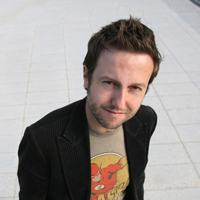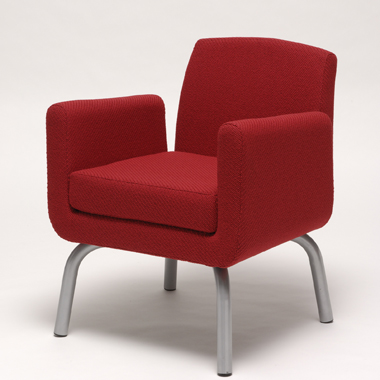TOM TWOPENY
 Matthew Sheargold graduated from the Canberra Institute of Technology, Australia in 1994 as dux of Interior Design. Matthew Sheargold graduated from the Canberra Institute of Technology, Australia in 1994 as dux of Interior Design.
Whilst Matthew is a qualified Interior Designer his passion for design combined with a strong work ethic and international experience have helped shape him into a diverse and confident designer.
Having worked primarily in architecture offices Matthew has attained an in-depth understanding and appreciation of the construction industry.
In addition to interior design Matthew has found success in furniture design with several collections released in Australia.
He was employed as a work experience student with Robert Peck von Hartel Trethowan's Canberra office in his final year of study and was subsequently offered a full time position upon completion of his studies.
Matthew stayed with RPvHT for 3 years during  which time he was exposed to all aspects of interior fitouts and worked on projects ranging in size from 100m2 to 30,000m2 across all sectors.He was also a finalist in the Sydney Morning Herald Young Designer of the Year Award and the Country Road Homewear Design Award. which time he was exposed to all aspects of interior fitouts and worked on projects ranging in size from 100m2 to 30,000m2 across all sectors.He was also a finalist in the Sydney Morning Herald Young Designer of the Year Award and the Country Road Homewear Design Award.
His success in both of these prestigious awards bought him to the attention of Woodmark who commissioned Matthew to design a waiting chair for their supplier network within Australia. The result was Eeni Meeni Myni Mo, a modest, contemporary take on the waiting chair.
It offered a selection of leg options from timber or metal to 4 legs or swivel in order to achieve a design which could be flexible without compromising the core aesthetic.
The simplicity and friendliness of the design, coupled with it's price point gave it instant appeal in the marketplace and to this day it is one of Woodmark's biggest selling products.
In addition to EMMM, Matthew designed the Gruve collection of ottoman's. Gruve is understated and restrained with simple detailing bringing it to life. Extruded aluminium becomes the legs and a fully upholstered seat, in variable lengths, forms the seat.
It is also available with a backrest making it a truly unique family. Both EMMM and Gruve were released into the market in October 1998.
In 1997 Matthew left RPvHT to join Woods Bagot in their Canberra office. This gave Matthew an opportunity to work within a large scale organisation and exposed him to a greater and more diverse client base including Ford and Medibank Private as well as the staple government fitouts which provide the Canberra design industry with the bulk of it's workload. Matthew stayed with Woods Bagot for 18 months until the call to travel became too great and in November 1998 he moved to London.
 Matthew saw his time away from Australia less about an opportunity to grow professionally and more about personal development, there's only so much experience a place like Canberra can offer! Matthew saw his time away from Australia less about an opportunity to grow professionally and more about personal development, there's only so much experience a place like Canberra can offer!
Matthew had fully intended to join friends in London working in pubs and soaking up the seedier side of the travel experience, however upon arriving he was instantly inspired by the melting pot that surrounded him and soon found himself working at RTKL, one of the worlds largest design firms.
RTKL specialise in a number of sectors including hospitality, entertainment, retail, healthcare and corporate interiors and Matthew worked across all of these in varying capacities.
He travelled considerably with RTKL, working on projects throughout Europe and USA. In addition to RTKL, Matthew spent time working with 2 other smaller, more specialised design firms - Harper Mackay and Sevil Peach Gence Associates, so that he would be exposed to as many and varied projects during his time away.
Whilst Matthew didn't produce any new furniture designs for production during his time in London, he did maintain a folio of ideas and concepts. After 4 years in London Matthew wanted to persue furniture design once more and decided to move back to Australia. Again Matthew collaborated with Woodmark and worked up many of the concepts he had been developing in London.The first of these designs to be completed was Play. The brief for PLAY was simple: 'design a compact sofa that is flexible and that can be produced cost effectively'. The success of the final design is due, in equal parts, to it's ease of manufacture, restrained but confident form, flexibility and it's consideration to the end user.
PLAY was designed for ease of manufacturing from the outset. By limiting the system to 2 modules the setup costs (prototypes) are greatly reduced. Instead of having to prototype an entire family of pieces (single, 2 seat, 3 seat etc), only 2 modules were ever needed to create each scenario saving valuable labour time. Cut foam has been used as opposed to cold cured foam once again as an aid to keeping set up costs low by removing the need for costly moulds. Likewise a standard leg detail has been adopted for the entire system.
The strength of PLAY is it's form. In plan it's strong rectilinear geometry affords it maximum flexibility when reconfiguring, in elevation however, it is softened by the deep, sweeping curves at the base. This lounge feels different from varying viewpoints and coupled with its infinite modularity, PLAY has the opportunity to take on many guises. In addition, consideration has been given to the location of each of PLAY's seams giving the specifier freedom to use contrasting fabrics to further enhance the form without compromising the design.
PLAY was designed for both the commercial and residential markets. It not only has to comply with the high standards of manufacturing that the commercial market demands but also the sensitivities of the domestic market. PLAY looks as comfortable in bars and waiting areas as it does in break-out spaces and living rooms. PLAY looks as comfortable in bars and waiting areas as it does in break-out spaces and living rooms.
It responds directly to the demands of todays society by being modular and highly flexible. There is never a question as to whether it will fit in a space or indeed fit in the elevator! Aesthetically it is designed not as a standout piece but rather to compliment and support and environment's aesthetic. That said, consideration with fabric selection can allow PLAY to take center stage.
At the same time Matthew had been working on a design for a range of stools and bench seats. The playful collection, called 'Zip', relies on a simple zip detail which finds it's way around each piece and creating a control mechanism to divide the contrasting fabrics.
The pieces were first used for a series of fitouts for Fuji Xerox across Asia and Australia and have now been released to the broader market.
了解更多设计师介绍,请点击进入【OF365学校家具网:www.of365-education.com 】
|
